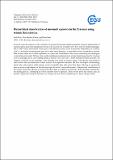Por favor, use este identificador para citar o enlazar a este item:
http://hdl.handle.net/10261/203027COMPARTIR / EXPORTAR:
 SHARE
BASE SHARE
BASE
|
|
| Visualizar otros formatos: MARC | Dublin Core | RDF | ORE | MODS | METS | DIDL | DATACITE | |

| Título: | Hierarchical classification of snowmelt episodes in the Pyrenees using seismic data spectra. |
Autor: | Diaz, J. CSIC ORCID ; Sánchez-Pastor, Pilar CSIC ORCID ; Ruiz Fernández, Mario CSIC ORCID | Palabras clave: | Seismology | Fecha de publicación: | 7-abr-2019 | Editor: | European Geosciences Union | Citación: | Geophysical Research Abstracts, 21: EGU2019-3988 (2019) | Resumen: | In recent years the analysis of the variations of seismic background signal recorded in temporal deployments of seismic stations near river channels has proved to be a useful tool to monitor river flow, even for modest discharges. The CANF seismic broad-band station, part of the Geodyn facility in the Laboratorio Subterráneo de Canfranc (LSC), is located in an underground quiet site in the Central Pyrenees, at about 400 m of the Aragón River channel. This location offers an excellent opportunity to explore the possibilities of the seismic monitoring of hydrological events at long-term scale.We focus here on the identification and analysis of seismic signals generated by variations in river discharge due to snow melting during a period of six years (2011-2016). During snowmelt episodes, the temporal variations of the discharge at the drainage river result in seismic signals with specific characteristics which allow their discrimination of other sources of background vibrations. We have developed a methodology based only in the analysis of the seismic spectra to identify days with active thaw, hence allowing to monitor the time occurrence and intensity of the thawing stages for up to 6 snowmelt seasons. A hierarchical classification of the seismic spectra has allowed to group active thaw days according to the intensity of the discharge generated by the melting process, identifying up to four different types of episodes. These results prove that seismic data can provide a good tool to monitor snowmelt on a long-term scale, hence contributing to climate change studies. | Descripción: | EGU General Assembly 2019, in Viena, Austria, 7–12 April 2019 | Versión del editor: | https://www.geophysical-research-abstracts.net/egu2019.html | URI: | http://hdl.handle.net/10261/203027 | Identificadores: | issn: 1029-7006 |
| Aparece en las colecciones: | (Geo3Bcn) Comunicaciones congresos |
Ficheros en este ítem:
| Fichero | Descripción | Tamaño | Formato | |
|---|---|---|---|---|
| Diaz_EGU2019-3988.pdf | 33,71 kB | Adobe PDF |  Visualizar/Abrir |
CORE Recommender
Page view(s)
117
checked on 23-abr-2024
Download(s)
35
checked on 23-abr-2024
Google ScholarTM
Check
Este item está licenciado bajo una Licencia Creative Commons

